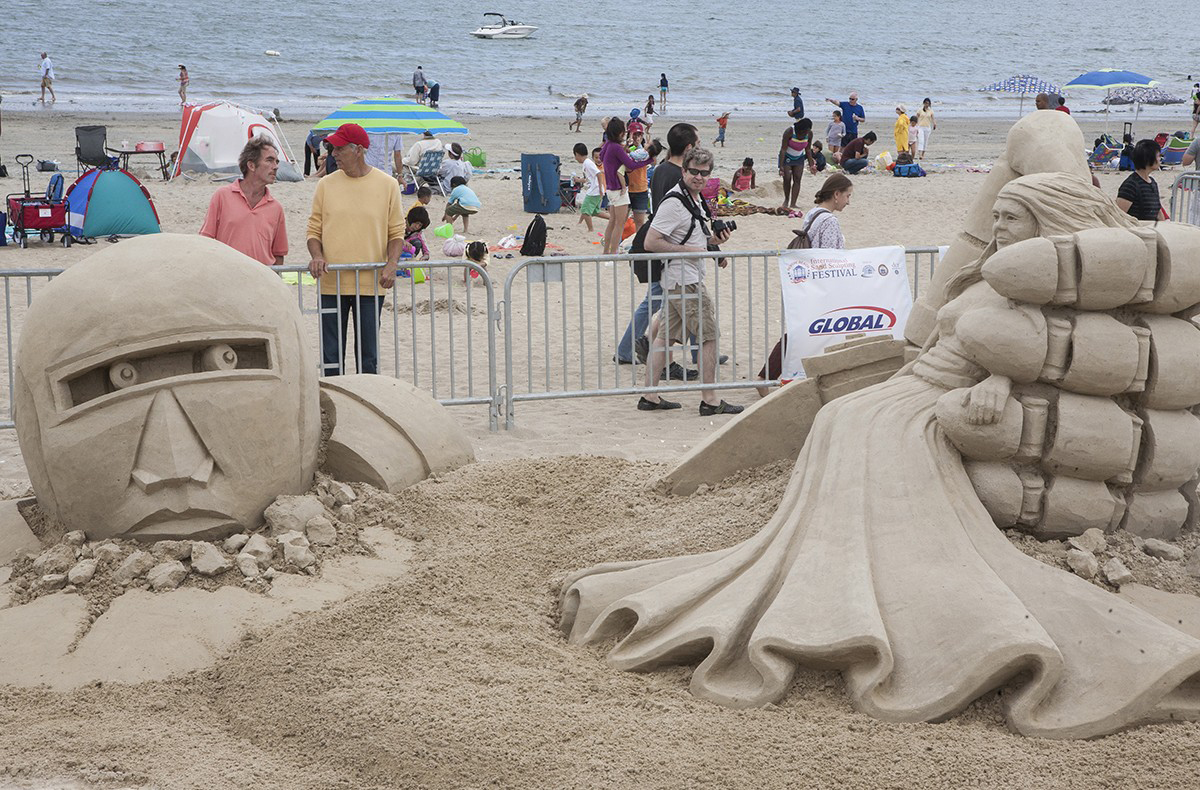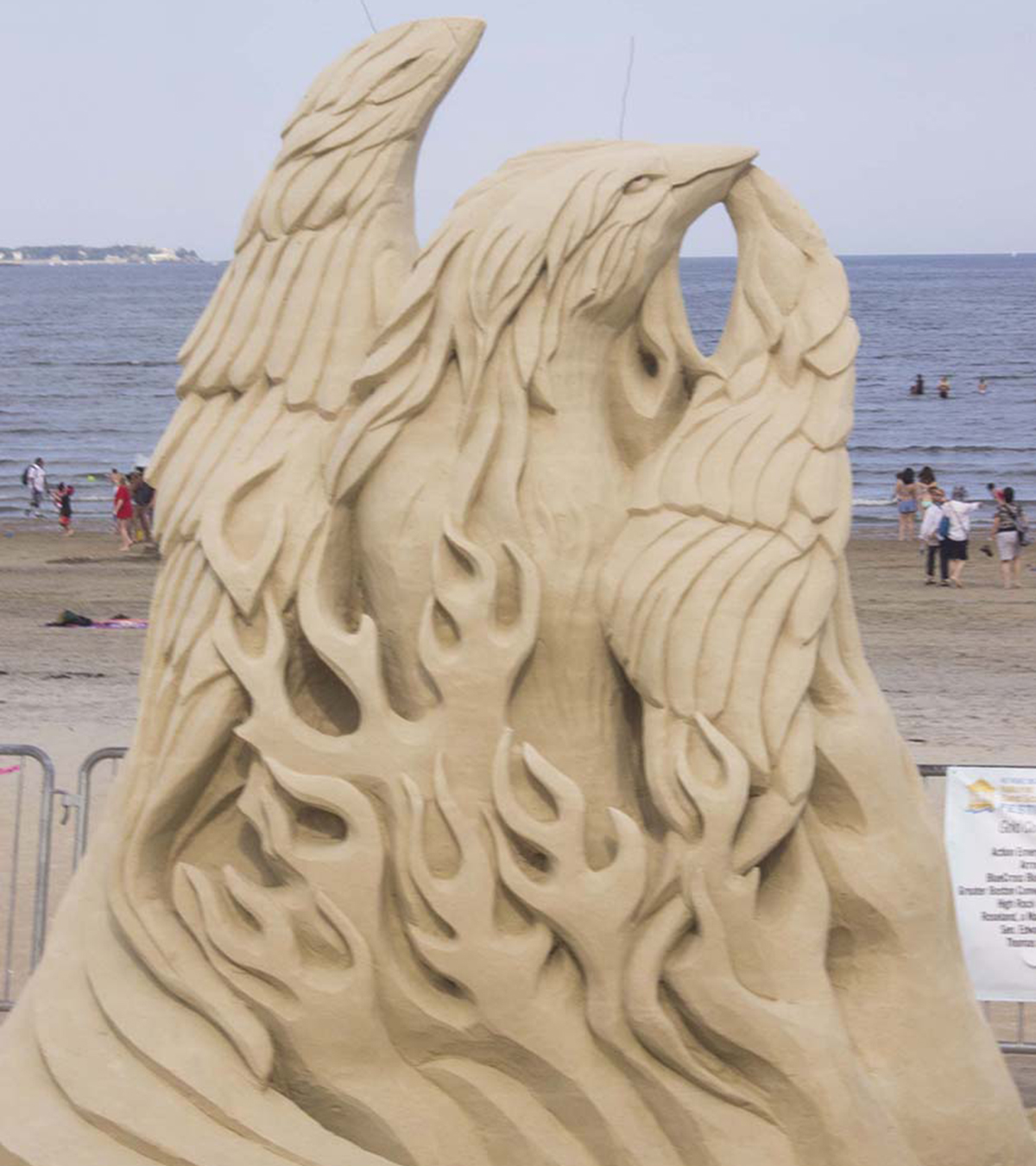What It’s Like to Be a Professional Sand Sculptor

‘Beauty and the Bot’ by Steve Topazio and Deb Barrett-Cutulle. / Photo by Olga Khvan
The Revere Beach International Sand Sculpting Festival attracts masters from around the world to local shores. But for Deborah Barrett-Cutulle and Steve Topazio, the journey isn’t so far. Barett-Cutulle lives in Saugus, and grew up in the Boston area, graduating with a degree from the Art Institute of Boston. Topazio lives in Tiverton, Rhode Island.
The sand-sculpting scene is intimate—especially locally. Topazio shares that there are only about four “masters” in New England and perhaps 300 internationally. “It’s a very tight network of sculptors,” Topazio says of the community. “As far as camaraderie, it’s a love-hate relationship. We’re competitive.” He laughs, before assuring, “It’s fun, it’s a lot of fun.”
So how did these artists find the niche?
“I run a karaoke show, and some friends in the audience told me about this event,” Barrett-Cutulle says. “That was in 2005. I went down and met a lot of people and they offered a spot in the sand, and it grew from there.”
Topazio has been in the sand for longer. Fifteen years ago he happened across a local competition and won. “I was so excited, because it was the first thing I ever won. Then I went online and I found out there was a professional world of this out there.” Several years later, Topazio was laid off from his job. What would be a disappointing blow for most turned out to be a stroke of luck for Topazio: he finally could make his sand-sculpting career official.
Topazio quickly learned though that seasons made sand-sculpting full-time nearly impossible in New England. He’s responded by branching off into other forms of sculpting, ranging from pumpkin carving to snowman-building.
This is Topazio’s second year partnering with Barrett-Cutulle. Last year was her first competition, but Topazio didn’t doubt her abilities. “We’ve known each other for 15 years, and we make good partners. We feed off each other. She comes up with the ideas, and I say, ‘Tell me what to do, Deb, and I’ll show you how to do it.’” he says.
In some ways, Deb was a natural from the moment she entered the scene sculpting the sponsors’ logos at the Revere festival for years. “Those logos really have to be dead-ass perfect, and Debbie is one of the best at that,” Topazio says. Barrett-Cutulle demurs that her artistic training in lettering explained her skill.
However, working in the competition revealed a more challenging part of sand-sculpting that she didn’t cover in art school: “being able to shovel 10 tons of sand into the form to create the blocks that we carve out of.”
Turns out sand-sculpting is filled with heavy manual labor. The process begins with compacting the sand with water. Sculptors then form the smaller blocks that will make up the piece of art. After preparation is complete, sculptors then carve the design, using a wide variety of tools ranging from palette knives to kitchen utensils—the part of the process where the sand takes its shape. Finally, the sculptors spray the finished product with “windscreen,” a solution made up of 90 percent water and 10 percent Elmer’s glue.
Though Barrett-Cutulle is new to the technical side of sand-sculpting, the artistic inspiration has always come naturally for her. “I have a love for concept,” she says. Her most recent idea will debut at this year’s sand-sculpting festival. She wanted to create an artist’s palette, filled with color. The problem: New England sand doesn’t naturally come in different colors, and the competition would not allow them to use dye. Her solution: sculpt objects to evoke each color—for example, a frog for green.
“The idea that we’re trying to get across here is that we’re trying to get people to see something that isn’t there,” she says.
Topazio is excited to bring Barrett-Cutulle’s idea to life, but his ideal sculpture might look a little different. “About five years ago, I did a really cool Hot Rod-type car piece up in Hampton beach, and I had more fun doing that piece than I think I ever did,” he says, explaining his lifelong love of cars.
Topazio closes by stressing that despite the careful artistry and heavy manual labor, being a professional sand sculptor really is fun. “It’s living the dream,” Topazio says. “I’m making sandcastles for a living. Who the hell does that?”
Who the hell, indeed.

‘Phoenix Rising’ by Steve Topazio. / Photo by Olga Khvan


